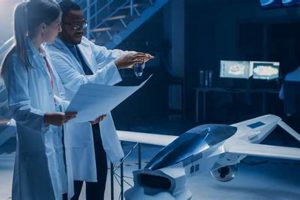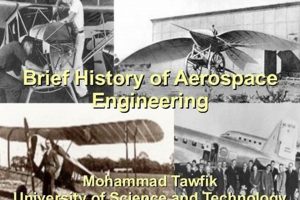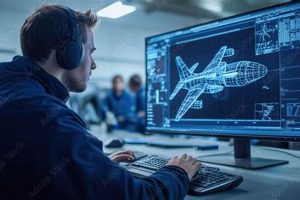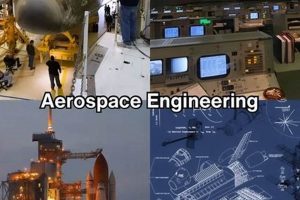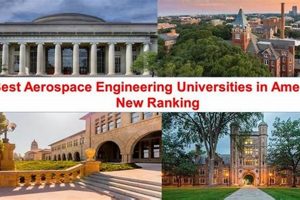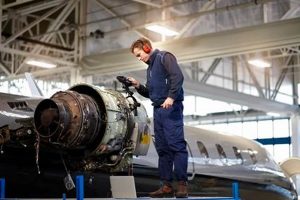Institutions offering specialized degree programs focused on the design, development, testing, and production of aircraft and spacecraft within the geographical boundaries of the nation constitute a significant segment of higher education. These centers of learning equip graduates with the skills necessary for careers in aviation, defense, and space exploration, fostering technological advancement in these fields. For example, the Indian Institute of Technology (IIT) system, and specialized institutes like the Indian Institute of Space Science and Technology (IIST), provide such comprehensive training.
Access to advanced curriculum, cutting-edge research facilities, and experienced faculty provides students with a competitive advantage in the global aerospace market. Historically, these institutions have played a critical role in supporting national aerospace programs, contributing to indigenous technological development and fostering innovation within the sector. The training provided contributes significantly to the skilled workforce available to both domestic and international aerospace organizations.
The subsequent sections will provide insight into factors to consider when evaluating such educational options, highlighting specific institutions recognized for their contributions to the aerospace domain, and discussing career prospects for graduates from these specialized programs.
Prospective students should undertake a thorough evaluation process to optimize their educational investment and career trajectory.
Tip 1: Accreditation and Recognition: Verify that the institution possesses necessary accreditation from relevant governing bodies, ensuring program quality and industry acceptance. Examination of rankings provided by reputable sources can offer further validation.
Tip 2: Faculty Expertise and Research: Evaluate the qualifications and research experience of the faculty. A strong research focus often translates to a more dynamic and intellectually stimulating learning environment. Review published research papers and faculty profiles for detailed insights.
Tip 3: Infrastructure and Resources: Investigate the availability of state-of-the-art laboratories, wind tunnels, computational facilities, and other resources crucial for practical learning and research. Modern equipment directly supports the learning experience.
Tip 4: Curriculum Relevance and Specializations: Assess the curriculum’s alignment with current industry trends and technological advancements. Look for specialized tracks, such as aerodynamics, propulsion, or structures, aligning with individual career aspirations.
Tip 5: Industry Collaborations and Internships: Prioritize institutions with strong ties to aerospace companies and research organizations. Internship opportunities provide invaluable practical experience and networking potential.
Tip 6: Alumni Network and Placement Record: Research the institution’s alumni network and placement record. A strong alumni network can provide mentorship and career opportunities, while a high placement rate indicates industry confidence in the program’s graduates.
Tip 7: Location and Accessibility: Consider the institution’s location and its proximity to aerospace hubs and research centers. Easy access to related industries can facilitate collaborations and career prospects. Assess accessibility from the perspective of cost of living and other factors relevant to a comfortable educational experience.
Diligent consideration of these factors allows prospective students to make informed decisions, maximizing the potential return on investment and establishing a strong foundation for a successful career in the aerospace sector.
The subsequent section will provide an overview of leading educational institutions recognized within the aerospace engineering domain.
1. Accreditation Standards
Accreditation standards serve as critical benchmarks for evaluating the quality and rigor of aerospace engineering programs. For institutions aspiring to be recognized among the leading providers of aerospace education, adherence to these standards is not merely a formality but a fundamental indicator of their commitment to excellence and industry relevance.
- Program Curriculum Evaluation
Accreditation bodies meticulously examine the curriculum to ensure it covers essential aerospace engineering principles and incorporates contemporary advancements. This includes verifying that courses are appropriately sequenced, learning objectives are clearly defined, and the content aligns with industry needs. For example, accreditation might require a certain number of credit hours dedicated to specific topics like aerodynamics, propulsion, and structural analysis, ensuring graduates possess a well-rounded foundation. Failure to meet these standards can result in probationary status or denial of accreditation, impacting the institution’s reputation and ability to attract top students and faculty.
- Faculty Qualifications and Resources
Accreditation standards mandate that faculty members possess appropriate academic credentials, research experience, and teaching competence. Review processes include assessing the faculty-to-student ratio, the availability of qualified instructors for specialized courses, and the resources provided to support faculty research and professional development. An institution striving to be among the elite must invest in recruiting and retaining highly qualified faculty, offering competitive salaries, providing access to research grants, and creating opportunities for continuous learning. This ensures students are taught by experts at the forefront of aerospace knowledge.
- Infrastructure and Laboratory Facilities
Accreditation assesses the adequacy and modernity of laboratory facilities, wind tunnels, computational resources, and other infrastructure essential for hands-on learning and research. Institutions are expected to provide students with access to state-of-the-art equipment that simulates real-world aerospace environments. For example, access to advanced simulation software for computational fluid dynamics (CFD) or finite element analysis (FEA) is crucial for students to gain practical experience in designing and analyzing aerospace structures. The availability of such resources enhances the learning experience and prepares graduates for the demands of the aerospace industry.
- Continuous Improvement and Assessment
Accreditation emphasizes a culture of continuous improvement through ongoing assessment of program effectiveness and student learning outcomes. This involves collecting data on student performance, soliciting feedback from employers and alumni, and using this information to refine the curriculum and teaching methods. Institutions seeking to maintain their accredited status must demonstrate a commitment to regularly evaluating their programs and implementing changes to enhance their quality and relevance. This iterative process ensures that programs remain aligned with industry needs and prepare graduates for success in the evolving aerospace field.
The presence of rigorous accreditation standards in institutions training aerospace engineers directly correlates with their ability to produce graduates who are well-prepared for the demands of the industry. This benchmark becomes a filter, helping identify programs dedicated to maintaining excellence in all areas of instruction and resources, and which are worthy of inclusion among leading aerospace engineering colleges.
2. Faculty Research
Faculty research serves as a cornerstone element differentiating premier aerospace engineering institutions within India. The volume and quality of faculty-led research significantly impact the educational experience, curriculum relevance, and overall reputation of such institutions. A strong research program attracts talented students and faculty, fostering a dynamic environment conducive to innovation and technological advancement. The presence of ongoing research projects directly translates into advanced learning opportunities for students, allowing them to participate in cutting-edge investigations and gain hands-on experience with emerging technologies. For instance, faculty engaged in research on advanced composite materials for aircraft structures contribute directly to the curriculum, ensuring students receive up-to-date information on the latest industry practices. The Indian Institute of Science (IISc) Bangalore, for example, demonstrates this connection through its faculty’s involvement in national aerospace programs and its emphasis on collaborative research with organizations like the Aeronautical Development Agency (ADA).
Furthermore, faculty research often attracts funding from government agencies, industry partners, and private organizations, providing resources for infrastructure development, equipment upgrades, and student scholarships. Such funding enables institutions to maintain state-of-the-art facilities and offer competitive financial aid packages, further enhancing their appeal to prospective students. Institutions with robust research programs are also more likely to forge strong collaborations with industry, facilitating internships, job placements, and joint research projects. These collaborations benefit both students and faculty, providing valuable practical experience and networking opportunities. A practical demonstration of this can be found in the collaborative research initiatives between IIT Madras and the Hindustan Aeronautics Limited (HAL), where faculty expertise is leveraged for solving real-world engineering challenges, while students gain invaluable industry exposure. Research in areas like propulsion systems, aerodynamics, and control systems further advances the national aerospace capabilities.
In summary, faculty research is not merely an ancillary activity but an integral component of leading aerospace engineering colleges in India. It directly influences curriculum quality, student learning outcomes, institutional reputation, and industry collaboration. Institutions prioritizing and investing in faculty research are better positioned to produce highly skilled and innovative graduates who can contribute to the advancement of the Indian aerospace sector. However, sustaining a strong research culture requires ongoing investment, strategic planning, and a supportive institutional environment. By addressing these challenges, India’s top aerospace engineering colleges can further solidify their position as centers of excellence in aerospace education and research.
3. Industry Partnerships
A synergistic relationship between educational institutions and the aerospace sector is a hallmark of leading aerospace engineering colleges in India. These collaborations manifest as sponsored research projects, curriculum co-development, guest lectures by industry experts, and, most critically, structured internship programs. The practical result of such partnerships is a more relevant and immediately applicable skillset for graduates entering the workforce. For example, the association between the Indian Institute of Space Science and Technology (IIST) and the Indian Space Research Organisation (ISRO) ensures that the curriculum remains closely aligned with the evolving needs of the national space program, while also providing students with unparalleled opportunities to gain hands-on experience in mission-critical projects. Similarly, partnerships with private aerospace firms like Tata Advanced Systems or Mahindra Aerospace grant access to advanced manufacturing processes and technological innovations.
Industry partnerships also facilitate the translation of academic research into tangible products and processes. Collaborative projects often address specific engineering challenges faced by aerospace companies, providing real-world validation for theoretical concepts and fostering a culture of innovation. These engagements frequently result in joint publications, patents, and the development of new technologies with commercial potential. The Defence Research and Development Organisation (DRDO) has a long history of collaborating with various IITs and other engineering colleges, fostering indigenous technology development in critical areas such as aircraft design, propulsion systems, and avionics. The presence of an active industry partnership program also serves as a crucial indicator of an institution’s commitment to providing career-ready graduates, thereby attracting high-caliber students and faculty alike.
In conclusion, industry partnerships constitute a vital component of leading aerospace engineering colleges in India. They bridge the gap between theory and practice, ensure curriculum relevance, facilitate research translation, and enhance graduate employability. While challenges such as bureaucracy, intellectual property concerns, and differing priorities may exist, the benefits of fostering strong industry-academia linkages far outweigh the difficulties. A sustained commitment to these collaborations will be crucial for ensuring the continued growth and global competitiveness of the Indian aerospace sector.
4. Infrastructure Quality
Infrastructure quality at institutions providing aerospace engineering education is a critical determinant of student preparedness and research advancement, directly influencing their standing among the top colleges within India. Adequacy and modernity of resources are essential for effective training and development within this technologically intensive field.
- Advanced Laboratories and Equipment
Access to state-of-the-art laboratories equipped with wind tunnels, propulsion system testbeds, and composite material fabrication facilities is paramount. These resources enable students to conduct experiments, validate theoretical concepts, and gain hands-on experience with industry-standard equipment. For instance, a college possessing a subsonic wind tunnel with advanced data acquisition capabilities can offer students invaluable practical exposure to aerodynamic principles, enhancing their understanding beyond textbook knowledge. A lack of such resources severely limits the practical application of theoretical knowledge.
- Computational Resources and Simulation Software
High-performance computing facilities and access to industry-grade simulation software for computational fluid dynamics (CFD), finite element analysis (FEA), and other engineering simulations are crucial. These tools allow students to model complex aerospace systems, analyze their performance, and optimize designs in a virtual environment. For example, access to ANSYS or similar software, coupled with sufficient computational power, enables students to simulate aircraft wing designs, assess stress distributions, and predict aerodynamic characteristics, leading to optimized and safer structures.
- Specialized Workshops and Fabrication Facilities
Workshops equipped with precision machining tools, 3D printers, and composite layup facilities enable students to translate designs into physical prototypes. This hands-on experience is essential for developing practical engineering skills and understanding manufacturing processes. A college possessing such facilities allows students to fabricate and test components for unmanned aerial vehicles (UAVs) or small satellite projects, thereby solidifying their understanding of design and manufacturing principles.
- Modern Classrooms and Learning Spaces
Well-equipped classrooms with audio-visual aids, interactive whiteboards, and comfortable seating arrangements contribute to an enhanced learning environment. Furthermore, dedicated project rooms and collaborative workspaces facilitate group projects and teamwork, essential skills for aerospace engineers. Access to online libraries, digital learning resources, and high-speed internet connectivity further supports academic research and knowledge dissemination.
The provision of high-quality infrastructure is a defining characteristic of leading aerospace engineering colleges. These resources empower students to engage in practical learning, conduct cutting-edge research, and develop the skills necessary for success in the demanding aerospace industry. Neglecting infrastructure investment inevitably compromises the quality of education and the competitiveness of graduates.
5. Curriculum Rigor
Curriculum rigor represents a fundamental characteristic differentiating leading aerospace engineering institutions within the Indian landscape. The depth, breadth, and intellectual challenge embedded within the academic program directly correlate with the graduate’s preparedness for the complexities of the aerospace sector and their ability to contribute to technological advancement.
- Depth of Core Subjects
A rigorous curriculum necessitates comprehensive coverage of core subjects, including aerodynamics, propulsion, structures, and control systems. This extends beyond introductory material to encompass advanced topics, providing a robust foundation for specialized study and research. For example, a top institution will not only cover basic aerodynamic principles but also delve into computational fluid dynamics (CFD) and boundary layer theory, equipping students with the analytical tools to address complex flow phenomena. The absence of this depth limits a graduate’s capacity to innovate and problem-solve in advanced aerospace applications.
- Emphasis on Mathematical and Computational Skills
Aerospace engineering relies heavily on mathematical modeling and computational analysis. A rigorous curriculum integrates advanced mathematical concepts, such as differential equations, linear algebra, and numerical methods, and emphasizes the application of computational tools for engineering problem-solving. Students at leading institutions are expected to develop proficiency in programming languages like MATLAB or Python and utilize commercial software for simulation and analysis. This skillset is indispensable for designing and analyzing aerospace systems, conducting research, and contributing to the digital transformation of the industry.
- Integration of Design and Project-Based Learning
Curriculum rigor demands the inclusion of design projects that challenge students to apply their knowledge to real-world problems. These projects typically involve the design, analysis, and prototyping of aerospace components or systems, such as aircraft wings, rocket engines, or satellite payloads. The best programs often culminate in capstone projects where students work in teams to address complex engineering challenges, fostering collaboration, problem-solving, and communication skills. This integration of design and project-based learning ensures that graduates possess the practical skills and experience necessary to contribute effectively to engineering teams.
- Exposure to Emerging Technologies and Research
A truly rigorous curriculum incorporates exposure to emerging technologies and research areas, such as advanced materials, additive manufacturing, artificial intelligence, and sustainable aviation. This ensures that students are aware of the latest advancements in the field and prepared to adapt to future technological changes. Leading institutions often integrate research projects into the curriculum, allowing students to participate in cutting-edge investigations and contribute to the advancement of knowledge. This exposure to research enhances critical thinking skills and prepares students for careers in research and development.
In summary, the defining characteristic of a top aerospace engineering college in India rests upon a curriculum designed to cultivate not only a thorough understanding of foundational principles, but also advanced analytical capabilities, hands-on experience with real-world design challenges, and a forward-looking perspective on emerging technologies, as this combination leads to highly capable and sought-after graduates.
6. Placement Records
Placement records serve as a tangible metric reflecting the efficacy of educational programs within institutions training aerospace engineers. For institutions aspiring to be recognized among the leading providers of such education, placement statistics represent a critical measure of their success in preparing graduates for careers within the industry.
- Direct Employment in Core Aerospace Sectors
A high percentage of graduates securing positions directly within core aerospace sectors, such as aircraft manufacturing, space exploration, or defense, indicates a curriculum aligned with industry needs and effective career preparation. Placement records demonstrating graduates employed at organizations like ISRO, HAL, or DRDO suggest strong industry connections and a reputation for producing qualified professionals. Conversely, low placement rates in these sectors may signal deficiencies in curriculum relevance or career support services.
- Competitive Salary Packages
The average and median salary packages offered to graduates provide insights into the perceived value of the institution’s education in the job market. Higher salary offers often reflect the graduate’s possession of specialized skills and knowledge sought after by employers. Comparisons of salary data across institutions can inform prospective students about the potential return on investment in their education. Sustained high salary averages are a strong indicator of program quality and industry demand for the institution’s graduates.
- Diversity of Placement Opportunities
The range of companies and organizations recruiting from an institution reflects the breadth of career opportunities available to its graduates. A diverse portfolio of recruiters, encompassing both public and private sector entities, as well as research institutions and consultancies, suggests a comprehensive education applicable to various career paths. A narrow range of recruiters may indicate a limited focus or a lack of recognition from certain segments of the industry.
- Graduate Studies and Research Pursuits
The percentage of graduates pursuing advanced degrees or research positions indicates the institution’s success in fostering a culture of intellectual curiosity and preparing students for academic careers. Placement records demonstrating a significant number of graduates enrolling in PhD programs or securing research fellowships at prestigious universities suggest a strong foundation in fundamental principles and a commitment to advancing knowledge within the aerospace domain. This facet demonstrates the capacity of a program to inspire and enable further academic achievements.
Analyzing placement records holistically, considering factors such as employment rates, salary packages, recruiter diversity, and graduate studies pursuits, provides a comprehensive assessment of an aerospace engineering college’s effectiveness in preparing students for successful careers. Institutions with consistently strong placement outcomes are more likely to be recognized among the leading providers of such education, attracting high-caliber students and contributing to the advancement of the aerospace sector.
7. Alumni Success
The accomplishments of graduates serve as a significant indicator of an aerospace engineering college’s efficacy in preparing individuals for impactful careers. The linkage between alumni achievement and the perceived status of these institutions is demonstrably causal: the success of alumni directly reflects the quality of the education, research opportunities, and professional development resources available at the college. Alumni employed in leading roles at ISRO, HAL, or prominent international aerospace firms serve as tangible evidence of a program’s capacity to cultivate talent. Their contributions to significant projects and innovations further validate the institution’s standing within the industry. For example, alumni leading critical components of a satellite launch mission or spearheading the design of a new aircraft model highlight the practical benefits of the education received.
Beyond individual accomplishments, the collective impact of alumni on the aerospace sector is a crucial measure of institutional success. A network of accomplished alumni, active in various facets of the industry, provides valuable mentorship, networking opportunities, and career pathways for current students. This network often facilitates internships, research collaborations, and job placements, reinforcing the college’s connection to industry demands. Furthermore, alumni contributions to research and development efforts, evidenced by publications, patents, and participation in national aerospace initiatives, contribute to the overall advancement of the field. Institutions actively cultivating alumni engagement and celebrating their achievements demonstrate a commitment to fostering long-term success for their graduates and the broader aerospace community. Examples of this include alumni-led startups focused on aerospace technology and alumni-driven philanthropic efforts supporting aerospace research at their alma mater.
In conclusion, alumni success serves as a critical validator of the quality and impact of aerospace engineering colleges in India. The achievements of graduates, both individually and collectively, underscore the practical value of the education and resources provided by these institutions. While challenges may exist in tracking and quantifying alumni success across diverse career paths, the sustained demonstration of alumni contributions to the aerospace sector remains a defining characteristic of top-tier programs. These achievements, in turn, drive institutional reputation, attract prospective students, and strengthen the college’s connection to industry demands, forming a positive feedback loop that benefits both the institution and the broader aerospace engineering ecosystem.
Frequently Asked Questions Regarding Top Aerospace Engineering Colleges in India
This section addresses common inquiries pertaining to institutions recognized for their aerospace engineering programs within India, offering clarity on key considerations for prospective students.
Question 1: What criteria define the “top” aerospace engineering colleges?
Institutions are evaluated based on accreditation, faculty qualifications and research output, infrastructure quality, curriculum relevance to industry needs, placement records, and alumni success. A holistic assessment considering these factors determines institutional standing.
Question 2: Are rankings the sole determinant of a college’s quality?
While rankings provide a comparative overview, they should not be the only basis for decision-making. Prospective students should also consider curriculum specifics, research opportunities, and faculty expertise aligned with individual career goals.
Question 3: How important are industry collaborations for aerospace engineering programs?
Industry partnerships are critical for providing students with practical experience, facilitating internships, and ensuring curriculum relevance to current industry practices. Institutions with strong industry connections often offer superior career prospects for graduates.
Question 4: What is the typical career trajectory for aerospace engineering graduates?
Graduates may pursue careers in aircraft design and manufacturing, space exploration, defense, research and development, or academia. Specific roles depend on individual specialization and skills, but demand for qualified aerospace engineers remains consistently high.
Question 5: What are the key skills that aerospace engineering programs aim to develop?
Programs focus on developing analytical and problem-solving skills, proficiency in mathematical modeling and simulation, knowledge of aerospace principles, and the ability to work effectively in multidisciplinary teams. Practical skills gained through laboratory work and design projects are also essential.
Question 6: How can prospective students prepare for admission to top aerospace engineering colleges?
Strong performance in mathematics and science subjects at the secondary level is crucial. Competitive entrance examinations, such as JEE Advanced, are typically required. Developing a strong foundation in physics and mathematics, along with demonstrating an interest in aerospace concepts, enhances admission prospects.
In summation, understanding the multifaceted evaluation criteria for leading institutions is crucial for prospective students to make informed decisions. The ultimate choice should align with individual academic and professional aspirations.
The subsequent section will provide concluding thoughts on navigating the landscape of aerospace engineering education in India.
The preceding exploration has elucidated the multifaceted characteristics defining the leading institutions offering aerospace engineering programs within India. Accreditation, faculty research, industry partnerships, infrastructure quality, curriculum rigor, placement records, and alumni success collectively shape the landscape of these educational centers. Prospective students are advised to approach the selection process with diligence, recognizing the long-term impact of this decision on their professional trajectory.
The continued advancement of the Indian aerospace sector hinges on the cultivation of highly skilled engineers and innovators. Therefore, students are encouraged to thoroughly evaluate potential institutions, prioritize programs that align with their individual aspirations, and contribute to the nation’s future technological achievements. The pursuit of excellence within aerospace engineering education remains a crucial endeavor, shaping the trajectory of national progress and global competitiveness.


